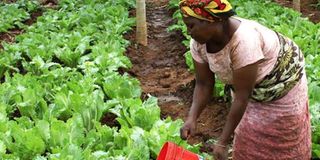EDITORIAL: It is time to wake up Tanzania's sleeping horticultural giant

What you need to know:
- Indeed, horticulture has great potential for ‘growing the economy.’ But, the potential is yet to be fully-tapped for inclusive and sustainable GDP growthand socio-economic development for Tanzania.
Most stakeholders one speaks to claim that‘horticulture’ is the proverbial sleeping giant in Tanzania’s economy.
Indeed, horticulture has great potential for ‘growing the economy.’ But, the potential is yet to be fully-tapped for inclusive and sustainable GDP growth and socio-economic development for Tanzania.
Roughly put, ‘horticulture’ is the science and art of growing fruits, vegetables, condiments, flowers, ornamental plants, etc. – all of which are highly-valued at both the domestic and export markets.
Horticulturists apply their knowledge, skills and technologies to grow intensively-produced cultivars for food and non-food uses, as well as for personal and social needs, including flowers... Tanzania is ‘alive and kicking’ within the eastern African horticultural league, boasting some six million tonnes in horticultural production in 2016.
And – as noted in The Citizen of October 10, 2017, horticulture“generated $642 million in export revenues last year (2016), a sharp rise from $64 million 10 years ago…”
If horticultural contribution to Tanzania’s economy skyrocketed by 1,003 per cent in a decade – doing so under most trying conditions– imagine what it could do under ideal conditions.
Frankly, ‘conditions’ for horticultural activities in Tanzania are far from ideal.
The main challenge is logistics in commercial transportation of goods to prime markets.
Horticultural harvests are mostly perishable
This is crucial – especially considering that horticultural harvests are mostly perishable – and require proper, expedited handling, storage, packaging and transportation to avoid losses.
This is another reason why Tanzania routes its horticultural exports through the Jomo Kenyatta International Airportin Kenya, rather through its own international airports.
These include the Songwe International Airport in Mbeya region, and the Kilimanjaro International Airport– both located slap-bang in horticulturally-productive parts of the country.
A new study – as noted in The Citizen on May 22 – identified the reasons why Tanzanian entrepreneurs perforce export their horticultural produce through Kenya. These include “inconsistent policies, bureaucracy, inordinately-high costs and lack of direct flights” to the right markets.
Compiled by the Tanzania Civil Aviation Authority (TCAA), the report affirms thatKenya has avoided these business-unfriendly ‘blights’(no pun intended here), where the horticultural business is cheaper and more efficient, with enough direct flights to global markers.
Kenya also has the requisite cold storage and transportation facilities for high-value, perishables.
As the TCAA director general, Hamza Johari, notes, “Tanzania is among the world’s 20 biggest horticultural producers – but isn’t among the 20 biggest horticultural exporters!”
This must now change. Tanzania should take a leaf (perhaps several leaves) out of Kenya’s book on horticulture – and finally take its rightful place in the global horticultural stakes.
It is past high time that the relevant authorities woke up Tanzania’s sleeping horticultural giant.




